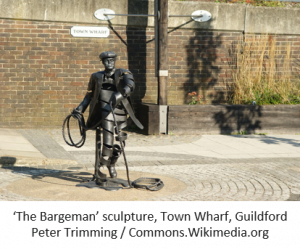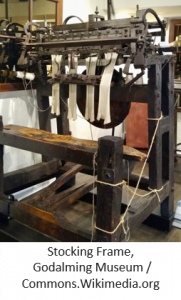EDWARD MITCHELL
Subject Na me : Edward Mitchell
me : Edward Mitchell
(b ca 1800 – d 1887)
Researcher : Diann Arnfield
Edward Mitchell was a bargeman in Godalming helping to bring prosperity to the town, but his own life was a struggle, serving time in prison for attempting to steal from his employer before ending his days in the Guildford Union Workhouse.
The details of Edward’s birth are unclear. Censuses indicate that he was born in Godalming somewhere between 1800 and 1809, but no positive baptism record has been found there for that period.
The first definite record found for Edward is his marriage on 3rd May 1831 to spinster Mary Stilwell at St Peter & St Paul’s Church, Godalming. Both were from Godalming with neither able to sign their name on the record. Like Edward, Mary’s origins are uncertain, but she is most likely to be the daughter of John and Hannah Stilwell baptised on 27th November 1808 at Witley, close to Hambledon which was given as her birthplace on the 1861 Census.
Occupations were not provided on marriage records at that time, but Edward would have been a bargeman, as their first child’s baptism record on 19th February 1832 noted him as such. The family were living in Mead Row, Godalming, a road close to Godalming Wharf, the starting point for the Godalming Navigation, so it is most probable that he was working on the barges here.
The late 1700s saw a large increase in goods being produced in Surrey, helped by the county’s natural supply of water to power mills. This growth meant that better methods of transport were needed to move goods around. The Godalming Navigation, completed in 1764, was constructed along the route of the River Wey, linking with the Wey Navigation built over 100 years earlier, thereby enabling barges to reach the River Thames near Weybridge and then on to the London Docks, a distance of around 50 miles (80km). The Godalming Navigation was also linked to the Wey & Arun Canal which opened in 1816, enabling goods to be transported to and from the English Channel at Littlehampton.
Godalming was thriving in the early 1800s when Edward was born. In 1801, the town was considerably larger than Guildford. With the mills along the River Wey producing and transporting paper, leather, timber and flour, added to local industry such as textiles/hosiery and goods made of iron, the work of bargemen would have been crucial to the success of the area.
Despite this, Edward and his family were experiencing tough times. After a second daughter Maria arrived in about 1834, the Guildford Poor Law Union Minute Books for 12th December 1840 noted that Edward’s family were awarded ‘Outdoor Relief – male paupers & their families for the reasons herewith:- Wife dropsey & him ill. Relief ordered:- 5 shillings & 4 loaves for a period of two weeks’. ‘Outdoor relief’ meant that they were supported at home, as opposed to ‘indoor’ being in the workhouse.
Six months later, the 1841 Census showed the family all together at Mead Row – Edward, age 32, a bargeman, wife Mary, also 32, and children Mary Ann, 9, and Maria, 7.
On 12th December 1847, Edward’s eldest daughter Mary Ann married bachelor Alfred Osbourn, a leather dresser, in Godalming’s St Peter and St Paul Church. The certificate noted Mary Ann to be aged 19, but she was almost certainly no older than 16. There must have been quite an air of tension in the church as Mary Ann was heavily pregnant, giving birth to Edward Frederick just two days later. Sadly, he died after just a few weeks.
The 1851 Census showed Edward, 42, still a bargeman, living in Mead Row with wife Mary, 44, and their younger daughter Maria, 17. Edward’s married daughter Mary Ann was also in Mead Row with husband Alfred and their second child, two-year-old Alfred.
Eight years later, Maria married Robert Scott in the St Peter and St Paul Church on 24th July 1859. He was a ‘frame-smith’ from Scotland, building, maintaining and repairing the frames u sed for making cotton stockings and hosiery. Framework knitting was a well-established industry in Godalming, as well as in the Scottish Borders, and the East Midlands. One of the types of machines he would have worked on is currently to be found in the Godalming Museum.
sed for making cotton stockings and hosiery. Framework knitting was a well-established industry in Godalming, as well as in the Scottish Borders, and the East Midlands. One of the types of machines he would have worked on is currently to be found in the Godalming Museum.
In 1844, a report for the House of Lords on the framework knitting industry, and in particular the effect the introduction of wide frames and steam powered mechanisation, counted 102 frames in Godalming, of which 55 were in use, with Godalming having the widest frame, being ’54 inch on the needles’. By the time of Maria and Robert’s marriage in 1859, this traditional industry was declining in Godalming, as hosiery factories were expanding elsewhere. They moved soon after their marriage to Leicester, the most important centre for the hosiery trade at the time, where they raised a large family.
Business at Godalming Wharf went into sharp decline from 1849 after the railway station was opened in the town, enabling freight to be moved more quickly than by waterway. This clearly had an effect on the Mitchells. In March 1861, Edward, a ‘jobbing barge man’, was convicted of attempting to steal coal from his master and was imprisoned for three weeks. His Wandsworth prison record described him as age 55, 5 feet 9 inches (1.75m) tall with grey hair and eyes and a fresh complexion. He weighed 11 stone 4 pounds (72kg).
The 1861 Census, just a few days after he was released from gaol, showed Edward and Mary, both age 54, living around the corner from Mead Row in Hare Lane with two lodgers. Edward gave his occupation as a bargeman, although the Census does not record if he was in employment after his attempted theft.
The following year, Edward’s wife Mary died on 12th July 1862 age 56 from dropsy, a condition she had been suffering from for over 20 years. Edward’s life was clearly becoming harder, and at times he was a Guildford Union Workhouse inmate. The Guildford Union Poor Law accounts (which only exist for 1864 to 1871) noted that he spent eleven days there in 1865 and 89 days in 1866.
Where Edward was at the time of the 1871 Census has not been discovered. Now well into his 60s, he was neither with his eldest daughter Mary Ann who was living in Bridge Street, Godalming with her family including her father-in-law, nor with his younger daughter Maria and family in Leicester. In fact, no further records have been found for Edward until the 1881 Census, when he was an inmate in the Guildford Union Workhouse, age 80, a widower, occupation ‘bargeman’.
There are no records to show when he had entered the Guildford Union Workhouse, but it seems likely that he spent his last years there, passing away on 12th September 1887 at the age of 87 from ‘gangrene of feet’ and ‘decay of age’. He was buried two days later in Nightingale Cemetery, Godalming.
November 2019, updated September 2023
Sources
Ancestry.co.uk
BarrowUponSoarHeritage.org.uk
Books.Google.co.uk
British History Online British-history.ac.uk
FindMyPast.co.uk / British Newspaper Archive
General Register Office GRO.gov.uk
Godalming Museum
Surrey History Centre, Woking Surreycc.gov.uk
Surrey History, Surrey Local Council
Wikipedia.org
Wikishire.co.uk
For a full list of references click here
